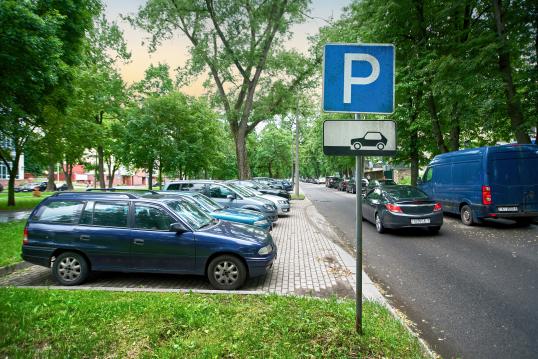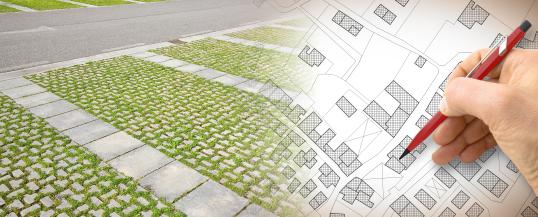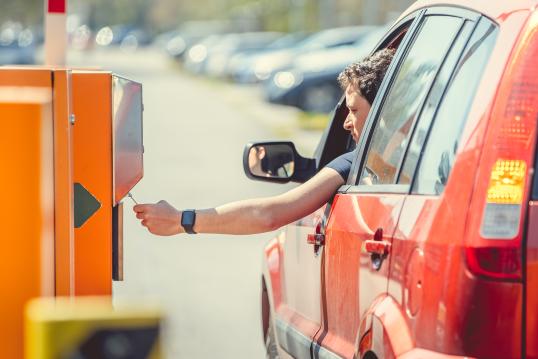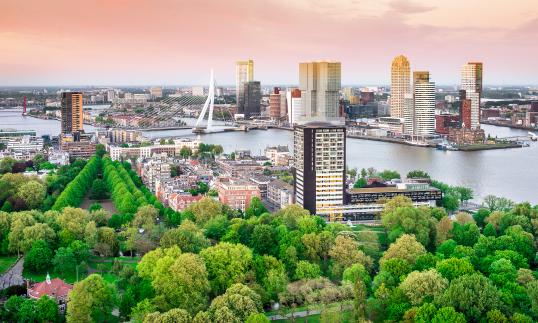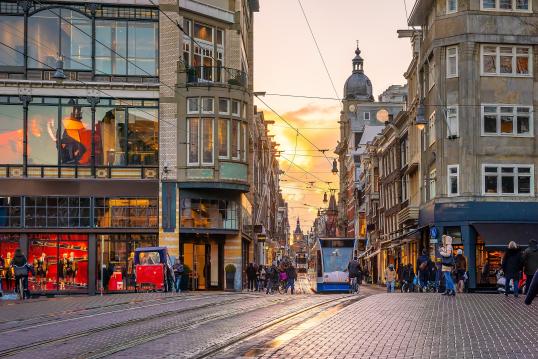- Topic
- Traffic and demand management
- Country
- Europe-wide
- Resource type
- Case study
First published 25 April 2024
Park4SUMP was a four-year European project funded from September 2018 until August 2022 under the Horizon 2020 programme, in the context of the CIVITAS initiative. The project aimed to help cities integrate innovative parking management solutions into Sustainable Urban Mobility Plans (SUMPs) to improve sustainable mobility and the quality of life for residents. The project sought to stimulate further innovation in parking management, turning parking policies from being reactive and operational to becoming more strategic, effective and holistic. Sixteen European cities teamed up with technical partners and parking organisations to demonstrate and transfer the benefits of strategically and smartly managed parking.
Park4SUMP concluded its work in September 2022, but the key principles and lessons drawn remain relevant to today’s post-COVID urban parking management and innovation.
In this case study, we highlight successful approaches adopted in different cities, that continue to build on the success of the project, supporting the transition from reactive to strategic and holistic parking management.
As it can take time for the desired impact to be achieved after initial implementation, we look back at a number of longer standing measures that have now, years later, demonstrated proven benefits and changes in traffic and vehicle ownership trends. In addition, we share examples of recently adopted parking measures to illustrate the latest policy changes taking place, informed by the learnings of earlier implementation.
Context
In urban areas, there is a vital need to change from seeing parking as a purely operational task to a strategic planning approach. Decades of car-oriented policies, a lack of investment in public transport and lenient parking policies have incentivised car use and increased the number of parking spaces in cities throughout Europe. Parking in cities has significant impact on the use of public space, as well as on pollution and traffic congestion.
At the same time, parking management provides excellent opportunities to help manage mobility. Car trips end at parking spaces. Hence, the strategic management of parking spaces can be a powerful tool to manage demand for car use, traffic flows and congestion, taking into account the needs and challenges from citizens and the private sector. Compared to other transport policies aimed at managing car use, adjusting parking policies has clear advantages for a better managed urban space.
Parking management generally requires relatively low-cost investments, as it typically does not require big infrastructural changes. In addition, parking can generate revenues, which can be used to help fund its cost.
The public acceptability of parking management is increasing and is greater than, for example, additional road user charging. People are already used to some level of parking management in most cities and most people recognise the need for it. In addition, parking management can gradually be extended and/or intensified, so that people are not confronted with a sudden drastic change, as major changes often elicit resistance.
As parking management often does not require very large infrastructural changes and can be introduced gradually, it does not require lengthy planning and implementation processes, at least, not to the extent faced by some other measures, such as public transport planning, road pricing, and low emission zones, etc.
Still, while parking management can already be found in virtually all larger towns and cities in Europe, according to project coordinator Patrick Auwerx, parking policy has still ‘not been properly integrated within SUMPs’.
In the Park4SUMP project, 16 European cities (five leading cities and 11 follower cities) teamed up between September 2018 and August 2022 to demonstrate and transfer benefits of smart and strategic parking management. Through the integration of parking management into sustainable urban mobility planning, cities are not only addressing current issues and concerns but are helping to alleviate future mobility challenges. The COVID-19 pandemic had a significant impact on parking management due to behaviour change and travel patterns at that time, with people avoiding public transport in some cases to avoid transmission of the virus. As driving patterns return to, or in some cases even surpass, pre-COVID levels, strategic and effective parking management is increasingly important to avoid a step back in progress.
In action
To recap, the aim of Park4SUMP was to help partner cities to:
- Integrate parking management into their SUMPs;
- Free up an average of 10% of public space, which had previously been dedicated to parking; and
- Invest at least 10% of parking revenue into sustainable transport.
For parking management implementation activities, there are seven main areas for development, as follows:
- Extend general parking management: Manage parking demand by targeting the supply of parking spaces, e.g. introduce/extend parking fees, reduce parking time, etc.
- Use parking revenue to finance sustainable urban (mobility) measures: Free parking does not exist. If a driver does not have to pay for a parking spot in the city, the residents bear the cost of the operating, maintaining, and enforcing parking space. Instead, through the introduction of paid parking, drivers are encouraged to use more sustainable transport. Fees collected, for example from parking or public transport fees, can contribute to investments in sustainable initiatives. Furthermore, if parking revenues are used to improve mobility services, they improve the level of acceptance of parking policies.
- Modify parking standards; alter minimum requirements and introduce maximum allowances: Reducing parking requirements for new buildings and setting a maximum limit for the number of car parking spaces in new developments, has a real impact on how people choose to travel.
- Enhance enforcement: Effective enforcement is needed in the whole parking system to maximise its impact.
- Integrate parking management into sustainable urban mobility planning (SUMP): Move from a reactive and operational level of parking management to a strategic style of smart and sustainable parking management. This includes setting longer term goals and influencing behaviour.
- Technological innovation: Continuously implement technological innovations, such that sustainability, monitoring and efficiency are improved, e.g. automated enforcement (that scans cars), sensor data, mobility apps and parking guidance systems.
- Accompanying measures & living labs in neighbourhoods: Facilitate living labs using parking revenue to spur community building, decentralised planning, bottom-up development and sustainable innovation. Furthermore, this can increase the acceptance of paid parking.
Results
Many cities have been implementing parking policies in line with the Park4SUMP principles as listed above. The successes are numerous and have proven to be beneficial in delivering sustainable urban mobility in cities, as shown below by theme.
Reducing parking demand and traffic flows through city-wide parking standards
Parking standards for new development regulate how much parking is built. Parking standards can be used by local authorities as minimum or as maximum. It has been argued by many that minimum standards for parking contribute to over-supply, consuming urban public space, increase the costs of housing and other building projects and encourage car-use. For example, a recent study (McAslan and Sprei, 2023) using data on parking requirements and car ownership in 56 municipalities in Sweden between 2002 and 2020, finds that across all municipalities, there is a positive relationship between minimum parking requirements and car ownership. City size is an important factor in rates of car ownership, but the analysis shows that even among similarly sized municipalities, minimum parking requirements tend to be associated with higher rates of car ownership. Another study (Christiansen et al., 2017), combining data from the Norwegian National Travel Survey and additional geographical context data, finds that access to private or reserved parking triples the likelihood of car ownership.
Therefore, to facilitate modal shift away from private car use, movement away from minimum standards towards maximum standards is recommended.
Hamburg (DE) is an example of a city that is making strategic decisions when it comes to parking standards, and they continue to see benefits since policy changes were initially made in 2013, when the city decided to eliminate minimum parking standards for residential construction projects.
Prior to this, Hamburg’s building regulations required developers to provide evidence that a ratio of 0.8 parking spaces per residence (or 0.6 in central districts with multistorey residential buildings) had been met. While developers still need clarity about the expected mobility needs and the need for parking spaces as part of the building permit process, it is up to the developer to decide on the appropriate level of parking spaces to be constructed.
An evaluation conducted in 2018, concluded that the abolition of the obligation to include parking spaces in constructions in Hamburg led to a reduction in the number of parking spaces per residence. An average of 0.52 spaces were included in central urban areas and of 0.57 in the rest of the city. In addition, the evaluation concluded that parking spaces were being built to an appropriate extent even without any legal obligation and that the abolition of the requirement has led to a noticeable reduction in construction costs and eased the burden on building permit procedures.
Hamburg also introduced a cap on the number of parking spaces in restricted parking areas. In these areas, no more than 25% of necessary parking places may be built, based on a methodology set by the city. In the 2021 review of the building regulations, the policy has been reinforced and the restricted parking areas extended.
In Umeå (SE), the parking strategy integrates and acknowledges the differentiation of location, centrality and accessibility. Parking planners improve accessibility by providing spaces for visitors in central parking areas whilst shifting workplace parking, commuter parking, and long-term parking out of the city centre. Parking planners in the city employed a “parking pay-off” approach in May 2018. The scheme allows developers to pay a fee instead of providing parking in their developments. The fee can even be reduced if they provide sustainable travel alternatives. This pooling and restructuring of parking spaces, prioritising larger and more efficient off-street solutions, helps to reduce both urban congestion and the cost of new developments.
Shift from on-street to off-street parking and reducing on-street parking space
It is important to consider that the above-mentioned change in parking standards only affects new developments. At the same time, the availability of on-street parking spaces is an important driver, influencing car ownership and use. Such standards are only effective if parking is neither free nor freely available in nearby streets. For example, as explained by the Dutch Ministry of Infrastructure and the Environment, a rule of thumb being applied in the Netherlands is that where the occupancy rate is less than approximately 80%, the reduction of parking capacity has little or no impact on parking behaviour.
The city of Zurich (CH) has used a maximum ceiling for parking since 1989 and the parking cap is still in place today. This has contributed to a significant modal shift away from car-use in the city from 40% in 2000 to 29% in 2021. In this instance, there is a maximum number of parking spaces in central Zurich, and when an off-street parking space is added, it is stated that an on-street parking space should be removed.
In addition, the city of Oslo (NO) removed 800 on-street parking places in the city centre between 2016 and 2018 as part of the Car-free ‘Liveability Programme’, while the parking-garage capacity remained unchanged. An evaluation of the programme showed that the share of visitors using parking garages increased from 32% in 2017 to 40% in 2019, as did the share using private parking (from 12% in 2017 to 16% in 2019). As anticipated, the share using on-street parking decreased from 2017 (39%) to 2019 (29%). In addition, car traffic within the city centre reduced by 11% in the period 2016 to 2018, and by 19% between 2018 and 2019. Surveys revealed that the measures have not impacted on origin-destination patterns within the city centre, although drivers are making fewer trips by car, while the occupancy rate has increased from 1.41 to 1.85 passengers per vehicle.
The city of Rotterdam (NL) has also been actively removing on-street parking spaces to create space for other uses and increase the overall quality of public space. In recent years, the municipality has removed some 3,000 on-street parking spaces in the inner city. Parking spaces made way for terraces, green space, wider pavements, bicycle parking and bicycle lanes. Residents and local businesses have been involved in setting up experiments with (temporary) alternative use of parking spaces. This promoted a positive attitude towards the removal of parking space and illustrated possible alternative uses, making a tangible impact on the quality of public space for all to experience. In addition to removing on-street parking space, Rotterdam increased on-street parking charges, while reducing the fees for off-street parking. People can park for free in several of the park-and-ride facilities, located on the outskirts of the city, and use public transport to travel into the city.
Introducing and increasing on-street parking fees to reduce parking and traffic
Parking fees can be a useful tool to help reduce car-use and help improve air quality. High parking fees can reduce car use, affecting the number of trips and/or modal choice.
A recent study (Ostermeijer et al., 2022) demonstrated the impact of higher parking prices on both parking and traffic in Amsterdam (NL). In 2018, the municipality created a mobility plan with the objective of reducing the total number of cars in the city, while prioritising pedestrians, cycling and public transport. In April 2019, the municipality implemented a parking price increase of 65% to reduce traffic in the centre and make the city more ‘car-free’. The price is now €4.22 per hour on average. This increase varies greatly from neighbourhood to neighbourhood, as for example in the centre, one pays €7.50 per hour.
Based on an analysis of more than 80 million parking transactions, the study found the increase in parking prices caused overall hourly on-street parking demand to decline by around 17% and the number of arrivals to decline by 9%. In addition, traffic reduced by 2%–3%. The study also found negative, but much smaller, effects in the (commercial) off-street parking market, as off-street providers increased prices as a response to the policy, but to a lesser extent.
Vienna (AT) has also introduced on-street parking fees in a bid to reduce parking and traffic. The short-term parking zones were first introduced almost two decades ago and covered only the most central districts. The number of zones has gradually increased over time and in 2022, the zone covered virtually the entire Vienna agglomeration.
In their short-term parking zones, parking visitors must have a parking ticket (€ 2.50 per hour) from the first minute of parking onward, even for short stops to unload luggage, for example. Parking for residents is possible only with a parking ticket or "Parkpickerl" permit. Short-term parking applies on weekdays from Monday to Friday from 9am to 10pm and the parking is restricted to two hours. Low-cost parking is available on the edge of the city at Vienna's park-and-ride facilities from €4.10 per day. All park-and-ride facilities are directly connected to a metro line, making it easy and convenient to reach the city centre.
A survey in July 2021 showed that the majority (56%) of the population of Vienna are in favour of the expansion, while 37% are somewhat or very much against it. Despite some resistance to new parking measures, Vienna continues to develop a parking strategy and maximise its potential to steer traffic away from the city centre.
In 2022, the Vienna Chamber of Commerce introduced a new master plan that will guide the design of the 1st district in the coming years. One of their objectives is that city centre parking for non-residents will only be possible in garages. Another approach explored in the plan is to increase the price for residents’ parking from the current 10 euros per month.
Diversification of on-street parking fees
Differentiated parking fees, with high fees in the city centre and lower fees (or free) parking at park and ride facilities on the cities’ edges, can be an effective measure to reduce car-based last-mile transport in often congested city centres. Differentiated parking fees can also be used to promote the use of cleaner vehicles by people who do own a car. Several cities are differentiating parking fees according to a vehicle’s environmental impact.
In 2018, Madrid (ES) established a Low Emission Zone (LEZ), known as “Madrid Central” (MC), imposing traffic and parking restrictions according to environmental labels: (i) Vehicles with 0 (Zero Emission) label can circulate and enjoy free on-street parking without time restriction; (ii) Vehicles with ECO environmental labels can enter the LEZ and park on-street during regulated hours for a maximum of 2 hours; (iii) Vehicles with environmental labels C or B are not allowed to go through the LEZ or park on-street within its limits, though they can enter the LEZ if drivers pay for parking in a set of underground garages; and (iv) Vehicles with A or without an environmental label are not allowed to enter. In addition, parking fees differentiate according to the environmental label: no fee (100% discount), ECO (50% discount), C (10% discount), and A or without a label (25% penalty). The most polluting vehicle could pay from 0.32€ per 20 min to 9.85€ per 240 minutes (2019 prices), while the cleanest vehicle is free of charge.
A study on the impact of these measures (Gonzales et al., 2022) concluded that they resulted in a more efficient use of parking space and also encouraged drivers to switch to more sustainable modes. However, it also revealed that those with cleaner vehicles are reluctant to shift to public transport or active modes of travel due to the benefits stemming from the ownership of those vehicles, such as the possibility of enjoying free parking.
Setting fees for residential parking permits and reduction of permits
Many cities handle residential parking through on-street parking management and off-street parking requirements. Residential parking management usually means that visitors pay a fee to park, have a time limit on parking, or both, or are prohibited from parking altogether. Residents often need a parking permit, which authorises them to park in their neighbourhood. Residential parking management has been shown to be an effective measure in influencing both car-based travel and vehicle ownership through either pricing or rationing of permits or both.
An assessment of permit fees in the four largest metropolitan areas of the Netherlands (NL), indicates that annual residential parking costs in the city centre are around €1,000, or roughly 17% of car ownership costs, and are more than double the cost in the periphery (Ostermeijer et al.,2019). Empirical estimates indicate that the disparity in parking costs explains around 30% of the difference in average car ownership rates between these areas and corresponds to a price elasticity of car demand of about −0.7. In addition, it has been found that the costs of resident permits do not cover the actual market value. Increasing permit fees in the city centre of Amsterdam to the market value is expected to reduce average car ownership by 17–24%.
However, most cities are not setting resident parking permit fees at market prices. Low public support for higher prices, actual or perceived, has been the main barrier to do so. An example of this is in Baden-Württemberg (DE), where resident parking fees had not changed since a maximum of 30.70 euros/year was set in 1993. However, more flexible and cost-covering fees have been allowed more recently, since a change in the law in 2021. Fee differentiation can now be considered depending on criteria including size of the vehicle, number of vehicles per household, and quality of local public transport.
The impact of the cost of residential parking permits on vehicle ownership has also demonstrated in Barcelona (ES) following the introduction of city-wide on-street parking fees in order to tackle the high levels of non-resident/visitor parking. A subsequent fee reduction for residents was intended to increase public and political acceptability of the introduction of parking fees. However, the ‘preferential treatment’ of residents in this case resulted in unintended incentives that actually increased local car ownership.
In 2019, Amsterdam (NL), announced that it would systematically reduce inner-city parking spaces. The city planned to reduce the number of parking spaces in the city by around 1,500 a year, with a target of eliminating up to 11,200 parking spaces, i.e. some 72% of on-street parking spaces, by 2025, in an effort to create room for cyclists and pedestrians. Rather than revoke permits, the city will refuse to replace any permits that are given up when drivers give up their cars, move out of the city or pass away. The total number of permits the city issues also depends on the number of on-street parking places available. The households that do not receive a permit need to go on a waiting list, with an average waiting time of approximately one year. De Groote (2019) calculated that the car ownership of households decreases by two percentage points for each year they are on the waiting list. This implies that additional parking permits increase car ownership and thus parking pressure. The social costs of additional parking space are approximately €270 per permit per year, or €3.5 million for the city centre of Amsterdam.
While developing strategies to address and restrict levels of non-resident/visitor parking, it is also important to take into account the needs of different societal groups. Because of this, the European Commission have proposed to introduce a standardised European Disability Card which is to be recognised throughout the EU. The proposal, announced in September 2023, aims to simplify travel and enable free movement for people with disabilities. This initiative will ensure that special conditions and preferential treatment regarding access to parking apply to disabled people across all EU Member States.
Using smart technologies to improve parking management
In Valencia (ES), mobility is one of the pillars of the smart city strategy, while smart mobility has been playing a crucial role in the delivery of the SUMP. Among other priorities, the SUMP envisaged the need and potential to shift from ‘traffic management’ to ‘mobility management’. In line with this idea, the city has been continuously developing its comprehensive municipal system of intelligent traffic monitoring and management ever since the launch of the SUMP in 2013. Information is collected from a network of some 3,900 pre-existing traffic sensors and 1,000 smart traffic light units. Information from the road traffic network is increasingly combined with information obtained from parking sensors, as well as data from the public transport smart card, bike rental scheme and electric vehicle charging. In 2020, the city also launched a project to provide 1,060 smart parking spaces for people with reduced mobility that can be used for loading and unloading or for taxis. The system enables the intelligent management of these restricted-use parking spaces, showing whether spaces are available.
Smart technologies can also be used to improve enforcement in parking management, as seen in the case of Gdansk (PL). Gdansk has 6,129 controlled parking spaces and 329 parking meters. In 2020, they investigated the potential use of a scan car to improve efficiency of enforcement of these parking spaces and in 2021, they successfully implemented this, now scanning 500 vehicles per hour, of which less than 5% are fined. Overall, the introduction of the technology significantly increased the city’s parking enforcement efficiency.
Using parking revenue to encourage sustainable mobility
Municipalities and planners often hesitate to implement restrictive parking policies because residents regularly oppose any changes to on-street parking space. However, research indicates that a package of measures in which restrictive measures are combined with improved mobility, may increase popularity. Revenue collected from parking fees can be used to help fund sustainable mobility measures and improve the quality of public space. For example, a study in Frankfurt-Bornheim (DE) found that the majority of residents are still in favour of an extension of parking fees and parking restrictions, especially if revenue and parking space are (re)used for better liability.
Some cities in Poland, including Krakow (PL), are now seeing this measure in practice. Since 2019, a new national law has obliged cities with more than 100,000 inhabitants to reinvest at least 65% of the income from parking fees (and 100% of parking fines) into sustainable transport projects and the conservation of green spaces in city centres. The COVID-19 pandemic resulted in reduced parking revenue due to the temporary suspension of parking charges. However, the city of Krakow is keen to follow-through with this objective moving forward, as their 2022 budget outlined plans to spend about €15.5 million on sustainable transport projects, funded from parking.
Other cities, such as Ghent (BE), Barcelona (ES), Graz (AT) have also adopted policies in which part of parking revenues have been earmarked to pay for sustainable mobility measures.
Reducing parking spaces can have a positive impact on commercial areas and housing projects
Many European cities have removed on-street parking spaces from historic districts and shopping streets. Positive effects, such as reduced carbon emissions and congestion in city centres, efficient land use or revitalised public squares have been seen across European cities. Overall, more than half of the 16 Park4SUMP cities removed car parking spaces in favour of public transport routes, bike parking, bike lanes, and space for terraces. Vitoria-Gasteiz (ES), for example, removed a significant 1,200 on-street parking spaces in 2021.
Despite the air quality and land use benefits, the economic advantages of such an approach to parking are often questioned. In Brussels (BE), the ULB university conducted research to understand retailer perception of parking in shopping streets. The retailers shared concerns about financial implications due to potential restricted access of customers to the shopping districts. However, the results showed that these districts where parking spaces were removed, in fact, became more user-friendly and accessible, and the resulting increase in customer footfall had an overall positive impact on the local economy.
Similarly, in Oslo (NO), evaluations conducted after the street-space reallocation of roads and parking spaces to space for pedestrians and cyclists, found an increase in turnover in the city centre from 2017 to 2018 and higher turnover than in reference areas. They also found that the city centre has become a more popular place to establish businesses.
Alongside evidence that reduced car parking spaces does not negatively impact local businesses, it has been found that there should also be no negative impact on local housing prices. A study using data over a period of 30 years tested this and showed that paid parking in Amsterdam and Utrecht (NL) had no influence on real estate prices (De Groote et al., 2018).
A further study (Bondemark and Merkel, 2023) explored the effect of priced parking on property prices in Stockholm (SE) suburbs introduced in 2018. Apartment prices were negatively affected by an unexpected appeal and subsequent revocation of parking fees introduction. This finding is interpreted to mean that the introduction of priced parking yielded benefits to apartment residents in the studied areas, which were capitalised in the price of housing. The implied benefits to residents of the introduction of parking fees amounted to the equivalent of approximately €2.50 per day.
Challenges, opportunities and transferability
The results of the cases generate important insights for improving the integration of SUMPs into the wider city development. The key lessons are as follows:
- Free parking does not exist. Parking space is scarce and there are costs associated with its operation, maintenance, and enforcement, even if a parked car pays no charge. In addition, more parking spaces generally lead to more car use. Apparent parking shortages and/or a predicted increase in parking demand can be better solved through parking management than through an increase in parking supply. Management strategies can include time limitations, price setting, and improved enforcement.
- Effective parking management leads to a more sustainable modal choice and less congestion. Raising on-street parking prices significantly reduces parking demand, parking duration and overall traffic flows in urban areas.
- Reducing parking availability and earmarking parking revenues to support sustainable urban mobility measures act as incentives for people to use more sustainable transport modes. New urban developments should include maximum standards for car parking and minimum standards for bike parking to shift mobility use towards sustainable and active solutions. These standards can be area-oriented and should consider public transport accessibility, as well as evolve according to changing mobility patterns.
- Parking strategies should take diverse needs into account. The development of parking strategies should recognise and accommodate the needs of disabled people.
- Park and Ride facilities should replace, not add to, city-centre parking. These facilities should be located close to the travellers’ origins and not close to their destination, to encourage the use of urban public transport.
- Technological innovations, such as automated parking sensors, parking guidance systems, and scanning cars, can support the efficient allocation of parking spaces and effective enforcement strategies.
- There may be resistance to the introduction of new parking management by the general public. However, initial opposition turns to support when they realise the positive impacts. Thus, parking management does not necessarily lead to strong political tensions or election losses, if the management strategies are fair, transparent, and effective in improving the city’s parking situation and its quality of life. Besides, there is no clear link between retail success and the number of (paid) parking spaces. In most cities, car drivers contribute less to the local economy than shoppers who use more sustainable transport modes.
- Work-related traffic, such as commuting is less responsive to parking fees, as many workers use employer-provided parking, which is provided at no cost or low cost to employees. Although employers pay for the provided parking spaces on the employee’s behalf, they are charged at a cost that often exceeds the commuters’ willingness to pay. This implies a ‘welfare loss’, as parking spaces are supplied at prices higher than consumers’ willingness to pay for their use. In addition, tax-exempt subsidised parking at the workplace distorts commuter choices and encourages commuting by car (Russo et al.,2019).
In depth
- Park4SUMP
- Fields of Activities | Park4SUMP
- EN (web).pdf (park4sump.eu)
- A new spring and a new sound - Municipality of Amsterdam
- Citywide parking policy and traffic: Evidence from Amsterdam - ScienceDirect
- Amsterdam mobility fund (park4sump.eu)
- Park4SUMP_good_practise_Rotterdam_park_pricing-policy_final.pdf
- Microsoft Word - 4089_eindrapport_def (cedelft.eu)
- 20150608_push_pull_a4_en_web-1.pdf (europeanparking.eu)
- EuropesParkingUTurn_ENG.pdf (unece.org)
- Final Brochure_park4sump_civitas en_v03.indd
- Implementation_report_Umea_2022.pdf (ruggedised.eu)
- Social benefits of eliminating on-street parking spaces in shopping streets | Park4SUMP
- Valencia using smart city solutions to deliver on its SUMP - European Commission (europa.eu)
- Parking Trend International Magazine - Edition 4 - 2022
- PARK4SUMP_Good_Practise__Rotterdam-Enforcement_scanvehicles_draft.pdf
- SUMP2.0_Topic Guide_Parking and SUMP_EN.pdf (park4sump.eu)
- Microsoft Word - CS12_PUSH_measures_Parking Enforcement_Treviso_V2 TR.doc (park4sump.eu)
- Alabate, D., and Gragera, A. (2019). The impact of curbside parking regulations on car ownership, Institut de Recerca en Economia Aplicada Regional i Pública, Working Paper 2019/09, Pages 1-34, https://www.ub.edu/irea/working_papers/2019/201909.pdf
- Bigazzi, A., Rouleau, M. (2017) Can traffic management strategies improve urban air quality? A review of the evidence, Journal of Transport & Health, Volume 7, Part B, 2017, Pages 111-124, ISSN 2214-1405, https://doi.org/10.1016/j.jth.2017.08.001.
- Bondemark, A., Merkel, A. (2023). Parking not included: The effect of paid residential parking on housing prices and its relationship with public transport proximity, Regional Science and Urban Economics, Elsevier, vol. 99(C).
- CE Delft (2019) CO2-uitstoot mobiliteit in de Vervoerregio Amsterdam: Prognose van de uitstoot t/m 2030 en effecten van maatregelen. Delft, CE Delft.
- Christiansen, P., Fearnley, N., Usterud Hanssen, J., Skollerud, K. (2017) Household parking facilities: relationship to travel behaviour and car ownership, Transportation Research Procedia, Volume 25, 2017, Pages 4185-4195, ISSN 2352-1465, https://doi.org/10.1016/j.trpro.2017.05.366.
- De Groote, J., van Ommeren, J., & Koster, H. R. A. (2018). The Impact of Parking Policy on House Prices. Journal of Transport Economics and Policy, 52(3), 267–282. https://www.jstor.org/stable/90020694
- De Groote, J. (2019). The welfare implications of parking policy. [PhD-Thesis - Research and graduation internal, Vrije Universiteit Amsterdam].
- Gonzalez, J.N., Gomez, J. Vassallo, J.M. (2022) Do urban parking restrictions and Low Emission Zones encourage a greener mobility?, Transportation Research Part D: Transport and Environment, Volume 107, 2022, 103319, ISSN 1361-9209, https://doi.org/10.1016/j.trd.2022.103319.
- Guo, Z. (2016): From Parking Minimums to Parking Maximums in London, ACCESS 49, Fall 2016.
- Hagen, O.H., Tennøy, A., (2021) Street-space reallocation in the Oslo city center: Adaptations, effects, and consequences, Transportation Research Part D: Transport and Environment, Volume 97,2021, 102944, ISSN 1361-9209, https://doi.org/10.1016/j.trd.2021.102944.
- Kirschner, F., Lanzendorf, M. (2020). Support for innovative on-street parking policies: empirical evidence from an urban neighborhood. Journal of Transport Geography, vol 85 , issue C. DOI: 10.1016/j.jtrangeo.2020.102726
- McAslan, D., Sprei, F. (2023) Minimum parking requirements and car ownership: An analysis of Swedish municipalities,Transport Policy,Volume 135,2023,Pages 45-58, ISSN 0967-070X, https://doi.org/10.1016/j.tranpol.2023.03.003.
- Ostermeijer, F., Koster, H., van Ommeren, J (2019). Residential parking costs and car ownership: Implications for parking policy and automated vehicles, Regional Science and Urban Economics, Volume 77, 2019, Pages 276-288, ISSN 0166-0462, https://doi.org/10.1016/j.regsciurbeco.2019.05.005.
- Ostermeijer, F., Koster, H., H. Nunes, L., J., van Ommeren, (2022). Citywide parking policy and traffic: Evidence from Amsterdam, Journal of Urban Economics, Volume 128, 2022, 103418, ISSN 0094-1190, https://doi.org/10.1016/j.jue.2021.103418.
- Russo, A., van Ommeren, J., Dimitropoulos, A. (2019). The environmental and welfare implications of parking policies. Loughborough University. Report. https://hdl.handle.net/2134/13352660.v1
- Sammer, G.et al. (2019). Ausweitung der Parkraumbewirtschaftung in Wien : Nachher - Untersuchung der Ausweitung der Parkraumbewirtschaftung auf den 10. Bezirk (Favoriten) und 18. Bezirk (Währing) / im Auftrag der Magistratsabteilung 18 -Stadtentwicklung und Stadtplanung. GrazWien : ZIS+P Verkehrsplanung, März 2019. Wienbibliothek im Rathaus.
- TRAFFIX Verkehrsplanung GmbH. (2020). Ausweitung der Parkraumbewirtschaftung in Wien : Nachher-Untersuchung 11. Bezirk Endbericht / im Auftrag der Stadt Wien - Stadtentwicklung und Stadtplanung ; Wien : MA 18 - Stadtentwicklung und Stadtplanung, April 2020. Wienbibliothek im Rathaus.
Photo Credits: © - Tricky_Shark, Francesco Scatena, Eduard Goricev, trabantos, mihaiulia, f11photo, Maria Sbytova, vvoe, Jon Chica, Tom Gowanlock - no permission to re-use image(s) without separate licence from Shutterstock.

